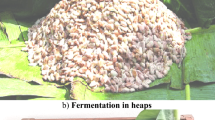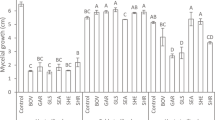Abstract
Samples of sundried, matured red pepper,Capsicum annum with a moisture content (MC) of 12.7–26.8 percent had on dry weight basis, vitamin C, 5.0–6.4 mg/100 g; crude protein, 0.8–1.2 percent; total soluble solids, 3.3–4.1 percent, and fungal counts of log 4.4–4.5/g. Ordinary matured redC. annum had MC, 75.7–78.2 percent vitamin C, 36.1–38.5 mg/100 g; crude protein, 2.4–2.8 percent; total soluble solids, 9.3–9.9 percent and fungal count of log 3.32–3.39/g. Sundried matured redC. frutescens had corresponding values of 9.4–18.7 percent; 5.8–6.3 mg/100 g; 0.8–1.1 percent; 0.9–2.6 percent and log 3.2–3.4/g. No aflatoxins were detected in sundried, matured redC. frutescens, but aflatoxin B1 values obtained fromC. annum varied from non-detectable to 2.2 µg/kg. Dominant fungi isolated fromC. annum andC. frutescens wereRhizopus oryzaze,Aspergillus niger,A. flavus,Geotrichum candidum andSaccharomyces spp.
Similar content being viewed by others
References
Farrell KT (1990) Spices, condiments and seasonings. Westport, CT: AVI.
Agboola SD (1973) Changes in bacteria flora of fresh pulpedCapsicum frutescens under various storage treatment. Trop Sci 15: 279–286.
Sill WH (1985) Plant protection. New Delhi: Kalyani Publishers.
AOAC (1975) Washington, DC: Association of Official Analytical Chemists.
AOAC (1970) Washington, DC: Association of Official Analytical Chemists.
Adegoke GO, Babalola AK, Akanni AO (1991) Effects of sodium metabisulphite, hydrogen peroxide and heat on aflatoxin B1 in lafun and gari: Two cassava products. Die Nahr 35: 1041–1045.
Adegoke GO, Ndife J (1993) Effect of sample pretreatments on the storability of ground melon ‘egusi’ (Colocynthis citrillus L.). Plant Food Hum Nutr 43: 77–85.
Rahman FMM (1976) Studies on quality changes in capsicum cultivars during maturation, ripening and processing. Diss Abst In B 37: 679–680.
NRC (1974) National Research Council. Recommended daily dietary allowance. Nutrition Rev 31: 373–395.
Matthews RF, Locascio SJ, Ozaki HY (1975) Ascorbic acid and carotene contents of pepper. Proceedings of the Florida State Horticultural Society 88: 263–265.
Pafumi J (1986) Assessment of the microbiological quality of spices and herbs. J Food Prot 49: 958–963.
Pivnick H (1980) Spices. In: RP Elliot et al. (eds), Microbial ecology of foods, vol. 2: Food Commodities. New York: Academic Press, pp. 731–751.
Atanda OO, Akano DA, Afolabi JF (1990) Mycoflora of dry ‘tatase’ pepper (Capsicum annum L.) stored for sale in Ibadan markets. Lett Appl Microbiol 10: 35–37.
Scott PM, Kennedy BPC (1973) Analysis and survey of ground black, white and capsicum peppers for aflatoxins. J Assoc Anal Chem 56: 1452–1457.
Author information
Authors and Affiliations
Rights and permissions
About this article
Cite this article
Adegoke, G.O., Allamu, A.E., Akingbala, J.O. et al. Influence of sundrying on the chemical composition, aflatoxin content and fungal counts of two pepper varieties —Capsicum annum andCapsicum frutescens . Plant Food Hum Nutr 49, 113–117 (1996). https://doi.org/10.1007/BF01091967
Received:
Accepted:
Issue Date:
DOI: https://doi.org/10.1007/BF01091967




